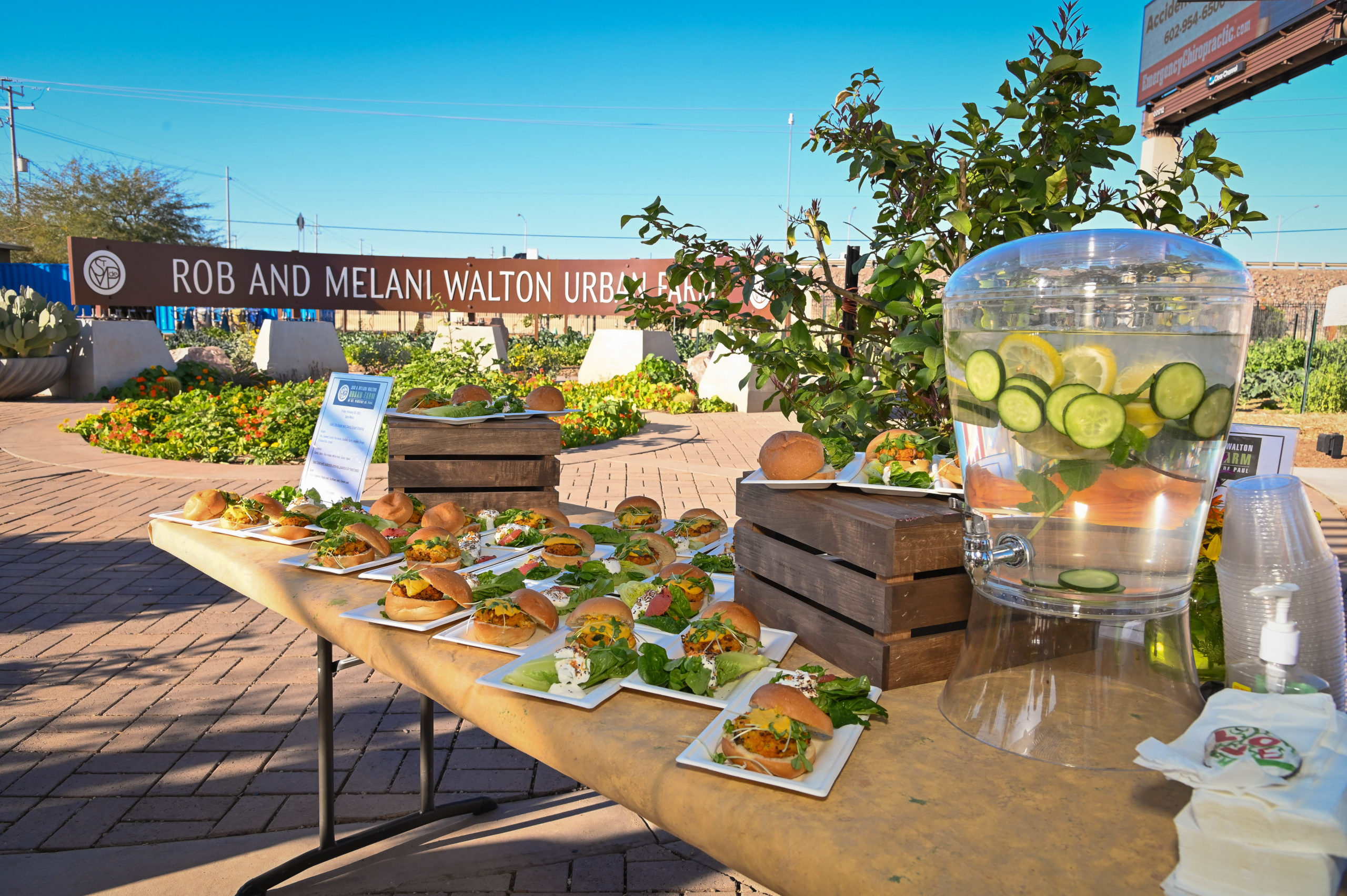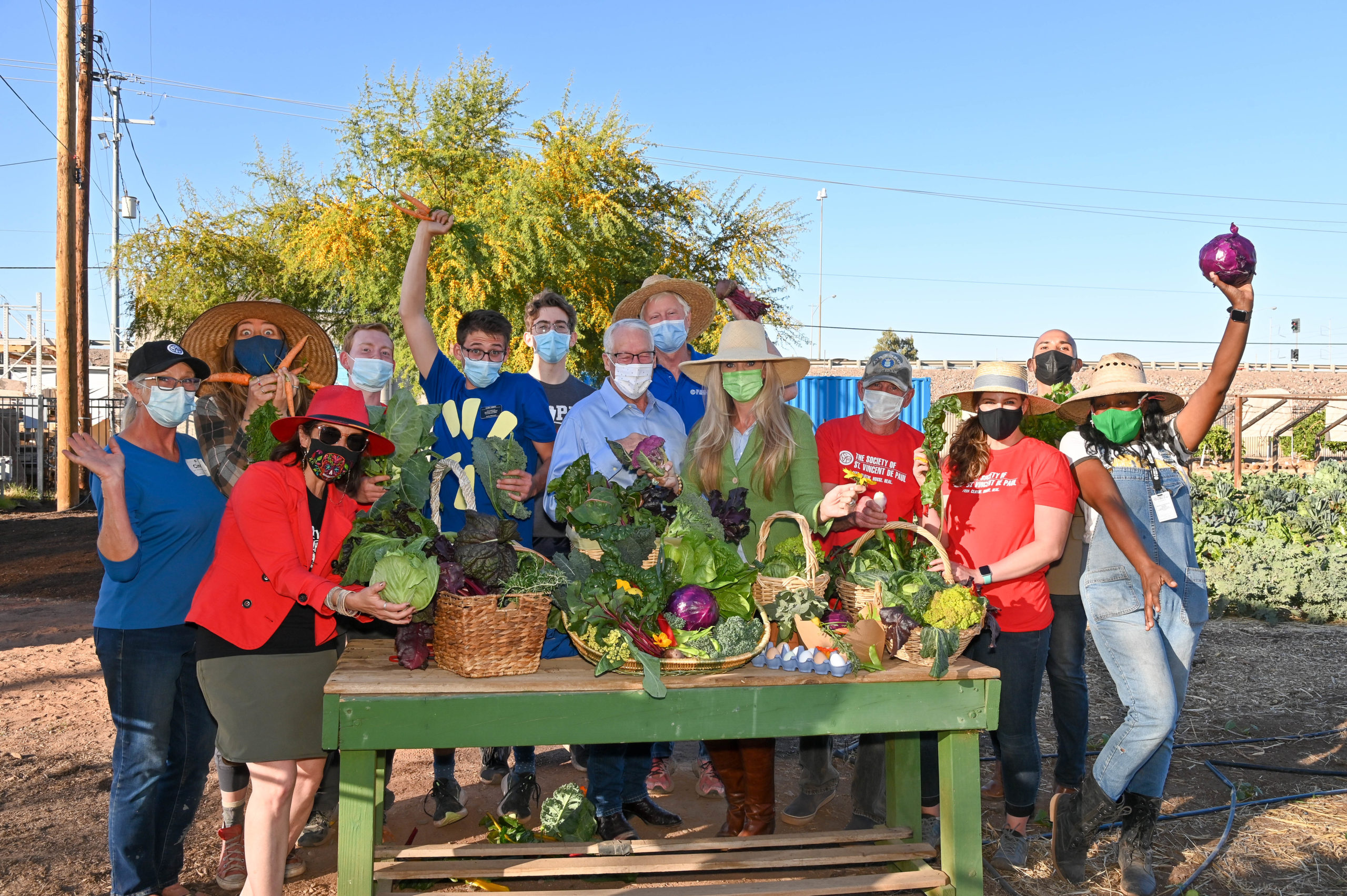The Waltons don’t just talk the talk, they walk the walk. When they see a need, they address it. We sat down with Melani Walton to talk about one of their local projects–the Urban Garden at St. Vincent de Paul, which began as a concrete parking lot and now acts as a garden that helps people facing food insecurity.
Here, how the Waltons are helping organizations working to save the planet.

You are very involved with sustainability through the Rob and Melani Walton Foundation (RMWF) and the Rob and Melani Walton Sustainability Solutions Service (WS3) at Arizona State University (ASU). Why is this a cause to which you’ve devoted yourselves?
A sustainable future for the planet is a sustainable future for all of us. We are just inhabitants on Mother Earth, and I’m sure you’ve heard the old saying, “If mamma ain’t happy, ain’t nobody happy.” Rob and I, along with the RMWF, have been exploring ways to better realize sustainability efforts in the world through a “feet in the mud, head in the sky” approach. By creating several outreach programs through a solutions service locally at ASU, along with national and global partnership organizations, we started planting seeds of sustainability in our community and beyond. Through our WS3 work at ASU, we are investing in innovative ways to help organizations and individuals make the transition to a more sustainable way of life—sustainable for the planet and sustainable in terms of our ability to continue new habits and practices.
Locally, one of your projects is the Rob and Melani Walton Urban Farm at St. Vincent de Paul. How did you become aware of St. Vincent de Paul (SVDP) and the opportunity with the farm?
St. Vincent de Paul in Arizona is well-known since it is the largest St. Vincent in the nation, serving around 150,000 clients each year. Our first interaction may have been when I was asked to speak at their morning Never Give Up program, when clients were coming in to receive breakfast. Later, a colleague on The Nature Conservancy board, Craig Weatherup, asked if I’d join him on St. Vincent’s advisory council, where I have served since 2013. I’ll never forget when Rob and I toured St. Vincent. Rob was chairman of Walmart for 23 years, and he was so impressed by their warehouse operations. You don’t get the organizational systems St. Vincent has in place without solid leadership. They have all heart in the front of the house, and a well-oiled machine behind the scenes. Rob and I had many discussions with St. Vincent’s Steve Zabilski and Shannon Clancy looking for alignment with our Foundation’s mission to elevate people, planet, and purpose. We noticed the large and mostly unused parking lot, and thought how great it would be to have farm to-table healthy options on site. Steve, Shannon, and their team (at SVDP) made it a reality. We were excited to involve the ASU – Walton Sustainability Solutions Service (WS3) students, who were pursuing sustainability degrees and needed experience in the field. They were able to provide several options and “green” possibilities that were implemented in the urban farm. Dozens of local businesses stepped forward with in-kind donations—from the irrigation systems to project design. Joni Mitchell sang about how “they paved paradise to put up a parking lot.” Together, we did the opposite. It’s a Garden of Eden in a concrete jungle.

What drew you to the project?
Rob and I both grew up in families that believed in the saying, “Grow where you are planted.” We were attracted to the opportunity to make a difference here in our own backyard. I grew up in a farming and ranching family in Montana, where we got our food from the source. Helping strengthen the connection people have to where their food comes from is important for creating connections back to nature and an opportunity to educate about healthy food choices. When we watch the children and young adults interacting in the garden, we see hope. We are very excited to be part of the St. Vincent community in realizing this tangible and sustainable benefit. Our collaboration further inspired us to have WS3 students work on sustainable building designs for The Rob and Melani Walton Campus of Liberty Wildlife just down the road in Phoenix. As a result, solar power meets 80% of energy demand, and cisterns harvest more than 56,000 gallons of rainwater on this campus where more than 9,000 animals receive care each year.
To date, SVDP’s Urban Farm, and its two additional farms inspired by the initial project, has harvested more than 51,000 pounds of fresh produce that has been prepared and served to people experiencing food insecurity. Why is that so important to you?
By helping meet a basic human need, St. Vincent and all its volunteers are making our community stronger, more tight-knit, and more secure. We also are looking out for our little ones—making sure they can develop in a healthy way with regular access to wholesome, nutritious foods, and helping make sure they grow up with an awareness of from where their food comes. Particularly during the pandemic, when so many are struggling, it is incredibly meaningful to connect with our community and our shared humanity. Neuroscientists will tell you one of the best things we can do for our own mental health is to take selfless action to help others.

What other benefits does the farm provide, and how can people get involved?
In addition to providing locally grown, healthy food, the farm has become a community gathering space (with appropriate social distancing). There is educational programming, from learning about the garden’s water recycling system to teaching about the importance of composting. We want all visitors to have the opportunity to interact with nature and gardening. St. Vincent’s mission is “Feed. Clothe. House. Heal.” This project started with the intention to feed and heal; over time, once the food production and operations were worked out, we were able to expand and ask, “How can this be a place for respite and renewal?” Today, you can find yoga classes, art therapy, and farm-to-table cooking demonstrations. The garden has grown into this outdoor place of connections that is welcoming to everyone.
What motivates you to give back?
Both Rob and I grew up in small towns with families that were involved in the community. Giving back was a way of life, and that work ethic and those lessons instilled in us from childhood remain. By investing in leaders who are making a difference and growing a vision together, we are able to build something greater than could ever be achieved alone. This garden delivers a very real return on investment in terms of community impact—and the ability to sustain and grow that impact over time. Only through strong leaders and partnerships, along with the support of our amazing team at RMWF, are we able to realize our foundation’s vision to Bring Life to Possibilities and Make It Matter. We are grateful to Sandy Nickerson and the team around her who manage our operations for the foundation.

With your focus on sustainability—what changes do you hope to see in the world?
Rob and I, like so many around the world, would like to see a more sustainable future for all life on Earth. Recently, I’ve had the honor of working closely with Emory University and His Holiness the Dalai Lama on #TheCompassionShift. His Holiness has written a book called Our Only Home, which makes the case that sustainability is for people and the planet. These interests are one and the same. For me, conservation has always been a humanitarian effort. I believe compassion is our most accessible and achievable sustainability plan. The leaders, staff, and volunteers at St. Vincent demonstrate compassion on every level.
What are some of the other organizations you’re passionate about?
Conservation International. My husband and I spent our first 20 months together traveling to 22 countries with scientists and conservation leaders. These travels were to distressed corners of the globe, where we worked to help identify the top hotspots in need of immediate intervention. Rob has served on the board for 18 years and been instrumental in their board operations and development. We are both heavily involved in African Parks. I presently serve on their board. Rob and the late Paul Fentener van Vlissingen were founding benefactors in 2000. Serving as the honorary president, Prince Harry is very proud of the organization’s accomplishments. African Parks now manages 19 parks in 11 countries covering approximately 35 million acres—roughly half the size of all national parks in the U.S. Currently, we are realizing the Theodore Roosevelt Presidential Library, where I serve on the board. The Library will be in the Badlands near the site of the Elkhorn Ranch, Theodore Roosevelt’s home ranch known as the “Cradle of Conservation,” which is now part of the Theodore Roosevelt National Park. Theodore Roosevelt was the original conservationist president—and it is an honor to work in his name for the future of conservation. This first fully digitized presidential library will represent the fulcrum of “The Hero’s Journey.”
Theodore Roosevelt set aside over 230 million acres of public lands. “Leave it as it is. You cannot improve on it,” Roosevelt said right here in Arizona upon setting aside the Grand Canyon. “What you can do is to keep it for your children, your children’s children, and for all who come after you.” In 2018, I was appointed by the National Park Service to the National Park Foundation board, and prior had served on The Nature Conservancy board for several years. Within the Valley, other boards I have served on include Arizona Women’s Board, Phoenix Children’s Hospital, The Phoenix Symphony, and Arizona Science Center (ASC). Within ASC, we created The W.O.N.D.E.R. Center (Walton Optimal Neurological Discovery Education & Research Center), and initially partnered with Barrow Neurological Institute and The Walton Outpatient Neuro-Rehabilitation Gym.
Our local W.O.N.D.E.R. Projects include Phoenix Theatre’s Partners That Heal, where actors create joy through performing arts for patients, such as those in The Phoenix Children’s Hospital, and Phoenix Symphony’s B-Sharp Music Wellness, where musicians perform in medical centers, as well as venues such as the Urban Farm at St. Vincent. Through our Walton Sustainability Solutions Service at ASU, seven initiatives were created for both local and global reach. One example is the Sustainability in Science Museums program, where museum educators can participate in content-rich trainings on bringing sustainability into people’s everyday lives; the initiative now reaches 200 museums in 32 countries and impacts over 75 million people. Rob and I also support the Earthshot Prize, initiated by Prince William, which is modeled on President Kennedy’s Moonshot goal. This is the largest global prize that seeks to inspire ingenuity and collective action that can, by 2030, improve life for generations to come.

Anything else you’d like to share?
Our biggest concern when the Urban Farm was just a vision was how to make sustainability… sustainable! This takes a lot of work, volunteers, and leadership. The team there—Dave Smith, Taylor Scarpelli, Nika Forte, and Mary Ann Ricketts—are making it happen day to day. Because most every dime of support goes right into helping people, the garden would not function without its volunteer network. It would not exist if so many local businesses had not given so generously of their time, expertise and resources. And, the community engagement with groups such as Pathways to Work, the Girl Scouts, LDS Youth, B-Sharp Music Wellness, and Leadership in Action adds a whole extra dimension to the impact. It took a community to create this oasis in the desert, and it takes a community to sustain it, enjoy it, and share in its growth. Rob and I are grateful to be part of this community.
For more information on the Waltons and St. Vincent de Paul, visit www.stvincentdepaul.net.
Keep up with all of Green Living‘s original content online and on social media.







